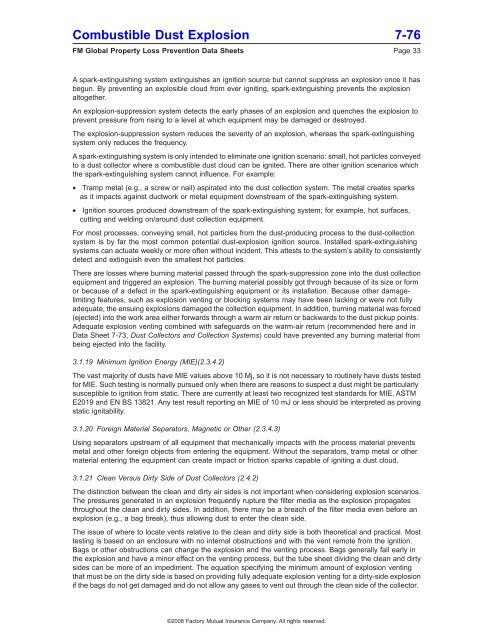DS 7-76 Prevention and Mitigation of Combustible Dust ... - FM Global
DS 7-76 Prevention and Mitigation of Combustible Dust ... - FM Global
DS 7-76 Prevention and Mitigation of Combustible Dust ... - FM Global
Create successful ePaper yourself
Turn your PDF publications into a flip-book with our unique Google optimized e-Paper software.
<strong>Combustible</strong> <strong>Dust</strong> Explosion 7-<strong>76</strong><br />
<strong>FM</strong> <strong>Global</strong> Property Loss <strong>Prevention</strong> Data Sheets Page 33<br />
A spark-extinguishing system extinguishes an ignition source but cannot suppress an explosion once it has<br />
begun. By preventing an explosible cloud from ever igniting, spark-extinguishing prevents the explosion<br />
altogether.<br />
An explosion-suppression system detects the early phases <strong>of</strong> an explosion <strong>and</strong> quenches the explosion to<br />
prevent pressure from rising to a level at which equipment may be damaged or destroyed.<br />
The explosion-suppression system reduces the severity <strong>of</strong> an explosion, whereas the spark-extinguishing<br />
system only reduces the frequency.<br />
A spark-extinguishing system is only intended to eliminate one ignition scenario: small, hot particles conveyed<br />
to a dust collector where a combustible dust cloud can be ignited. There are other ignition scenarios which<br />
the spark-extinguishing system cannot influence. For example:<br />
• Tramp metal (e.g., a screw or nail) aspirated into the dust collection system. The metal creates sparks<br />
as it impacts against ductwork or metal equipment downstream <strong>of</strong> the spark-extinguishing system.<br />
• Ignition sources produced downstream <strong>of</strong> the spark-extinguishing system; for example, hot surfaces,<br />
cutting <strong>and</strong> welding on/around dust collection equipment.<br />
For most processes, conveying small, hot particles from the dust-producing process to the dust-collection<br />
system is by far the most common potential dust-explosion ignition source. Installed spark-extinguishing<br />
systems can actuate weekly or more <strong>of</strong>ten without incident. This attests to the system’s ability to consistently<br />
detect <strong>and</strong> extinguish even the smallest hot particles.<br />
There are losses where burning material passed through the spark-suppression zone into the dust collection<br />
equipment <strong>and</strong> triggered an explosion. The burning material possibly got through because <strong>of</strong> its size or form<br />
or because <strong>of</strong> a defect in the spark-extinguishing equipment or its installation. Because other damagelimiting<br />
features, such as explosion venting or blocking systems may have been lacking or were not fully<br />
adequate, the ensuing explosions damaged the collection equipment. In addition, burning material was forced<br />
(ejected) into the work area either forwards through a warm air return or backwards to the dust pickup points.<br />
Adequate explosion venting combined with safeguards on the warm-air return (recommended here <strong>and</strong> in<br />
Data Sheet 7-73, <strong>Dust</strong> Collectors <strong>and</strong> Collection Systems) could have prevented any burning material from<br />
being ejected into the facility.<br />
3.1.19 Minimum Ignition Energy (MIE)(2.3.4.2)<br />
The vast majority <strong>of</strong> dusts have MIE values above 10 Mj, so it is not necessary to routinely have dusts tested<br />
for MIE. Such testing is normally pursued only when there are reasons to suspect a dust might be particularly<br />
susceptible to ignition from static. There are currently at least two recognized test st<strong>and</strong>ards for MIE, ASTM<br />
E2019 <strong>and</strong> EN BS 13821. Any test result reporting an MIE <strong>of</strong> 10 mJ or less should be interpreted as proving<br />
static ignitability.<br />
3.1.20 Foreign Material Separators, Magnetic or Other (2.3.4.3)<br />
Using separators upstream <strong>of</strong> all equipment that mechanically impacts with the process material prevents<br />
metal <strong>and</strong> other foreign objects from entering the equipment. Without the separators, tramp metal or other<br />
material entering the equipment can create impact or friction sparks capable <strong>of</strong> igniting a dust cloud.<br />
3.1.21 Clean Versus Dirty Side <strong>of</strong> <strong>Dust</strong> Collectors (2.4.2)<br />
The distinction between the clean <strong>and</strong> dirty air sides is not important when considering explosion scenarios.<br />
The pressures generated in an explosion frequently rupture the filter media as the explosion propagates<br />
throughout the clean <strong>and</strong> dirty sides. In addition, there may be a breach <strong>of</strong> the filter media even before an<br />
explosion (e.g., a bag break), thus allowing dust to enter the clean side.<br />
The issue <strong>of</strong> where to locate vents relative to the clean <strong>and</strong> dirty side is both theoretical <strong>and</strong> practical. Most<br />
testing is based on an enclosure with no internal obstructions <strong>and</strong> with the vent remote from the ignition.<br />
Bags or other obstructions can change the explosion <strong>and</strong> the venting process. Bags generally fail early in<br />
the explosion <strong>and</strong> have a minor effect on the venting process, but the tube sheet dividing the clean <strong>and</strong> dirty<br />
sides can be more <strong>of</strong> an impediment. The equation specifying the minimum amount <strong>of</strong> explosion venting<br />
that must be on the dirty side is based on providing fully adequate explosion venting for a dirty-side explosion<br />
if the bags do not get damaged <strong>and</strong> do not allow any gases to vent out through the clean side <strong>of</strong> the collector.<br />
©2008 Factory Mutual Insurance Company. All rights reserved.

















